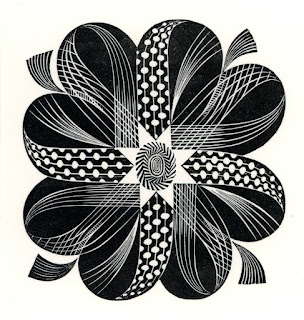 |
| Sydney Lee The Village Street 1916 wood-engraving Royal Academy of Arts, London |
 |
| Sydney Lee Venetian Merchant 1928 wood-engraving Royal Academy of Arts, London |
 |
| Gerald Brockhurst The Mirror 1920 etching Royal Academy of Arts, London |
 |
| Gerald Brockhurst By the Window 1922 etching Royal Academy of Arts, London |
 |
| Eric Ravilious Ribbon Device 1934 wood-engraving Royal Academy of Arts, London |
 |
| Eric Ravilious The Kitchen Garden in October 1937 wood-engraving (book illustration) Royal Academy of Arts, London |
 |
| Stanley Anderson The Violin Maker ca. 1930-40 engraving Royal Academy of Arts, London |
 |
| Stanley Anderson The Thatcher ca. 1930-40 engraving Royal Academy of Arts, London |
 |
| Stanley Anderson Between Tides, Dieppe ca. 1930-40 engraving Royal Academy of Arts, London |
 |
| Gertrude Hermes Stonehenge 1963 woodcut Royal Academy of Arts, London |
 |
| Norman Stevens Private Gate 1976 etching Royal Academy of Arts, London |
 |
| Bill Jacklin The Bather 1992 etching Royal Academy of Arts, London |
 |
| Bill Jacklin Two Men Talking 1992 etching Royal Academy of Arts, London |
 |
| Jennifer Dickson Vanbrugh's Bridge over Brown's Lake (Blenheim) 1993 photo-etching Royal Academy of Arts, London |
 |
| Jennifer Dickson Sibilant Staircase (Belvoir) 1993 photo-etching Royal Academy of Arts, London |
 |
| Eileen Cooper Search 2001 linocut Royal Academy of Arts, London |
 |
| John Lawrence Lyra's Oxford 2003 hand-colored wood-engraving Royal Academy of Arts, London |
Pretty Convincing
Talking to my friend Emily, whose drinking
patterns and extravagance of personal
feeling are a lot like mine, I'm pretty
convinced when she explains the things we do
while drinking (a cocktail to celebrate the new
account turns into a party that lasts till 3
a.m. and a terrific hangover) indicate
a problem of a sort I'd not considered.
I've been worried about how I metabolize
the sauce for four years, since my second bout
of hepatitis, when I kissed all the girls
at Christmas dinner and turned bright yellow
Christmas night, but never about whether
I could handle it. It's been more of a given,
the stage set for my life as an artistic queer,
as much of a tradition in these New York circles
as incense for Catholics or German
shepherds for the blind. We re-enact
the rituals, and our faces, like smoky icons
in a certain light, seem to learn nothing
but understand all. It comforts me
yet isn't all that pleasant, like drinking
Ripple to remember high school. A friend
of mine has been drinking in the same bar for decades,
talking to the same types, but progressively
fewer blonds. Joe LeSueur says he's glad
to have been a young man in the Fifties with his
Tab Hunter good looks, because that was the image
men desired; now it's the Puerto Rican
angel with great eyes and a fierce fidelity
that springs from machismo, rather than a moral
choice. His argument is pretty convincing, too,
except lots of pretty blonds I've known
default by dying young, leaving the field
to the swarthy. Cameron Burke, the dancer
and waiter at Magoo's, killed on his way home from
the Pines when a car hit his bike on the Sunrise Highway.
Henry Post dead of AIDS, a man I thought would be around
forever, surprising me by his mortality the way
I was surprised when I heard he was not
the grandson of Emily Post at all, just pretending,
like the friend he wrote about in Playgirl, Blair Meehan,
was faking when he crashed every A List party for a year
by pretending to be Kay Meehan's son, a masquerade
that ended when a hostess told him "Your mother's here"
and led him by the hand to the dowager – Woman, behold
thy son – underneath a darkening conviction that all,
if not wrong, was not right. By now Henry must have faced
the same embarrassment at some cocktail party in the sky.
Stay as outrageously nasty as you were. And Patrick
Mack, locked into memory as he held court in the Anvil
by the downstairs pinball machine, and writhing
as he danced in Lita Hornick's parlor when the Stimulators
played her party, dead last week of causes I don't know,
as if the cause and not the effect were the problem.
My blond friend Chuck Shaw refers to the Bone-
crusher in the Sky, and I'm starting to
imagine a road to his castle lit by radiant
heads of blonds on poles as streetlamps for the gods,
flickering on at twilight as I used to do
in the years when I crashed more parties and acted
more outrageously and met more beauties and made
more enemies than ever before or ever again, I pray.
It's spring and there's another crop of kids
with haircuts from my childhood and inflated self-esteem
from my arrival in New York, who plug into the history
of prettiness, convincing to themselves and the devout.
We who are about to catch the eye of someone
new salute as the cotillion passes, led by blonds
and followed by the rest of us, a formal march
to the dark edge of the ballroom where we step out
onto the terrace and the buds of the forsythia
that hides the trash sprout magically
at our approach. I toast it
as memorial to dreams as fragile and persistent
as a blond in love. My clothes smell like the smoky
bar, but the sweetness of the April air's
delicious when I step outside and fill
my lungs, leaning my head back
in a first-class seat on the shuttle
between the rowdy celebration of the great deeds
to come and an enormous Irish wake in which
the corpses change but the party goes on forever.
– Tim Dlugos (ca. 1990)